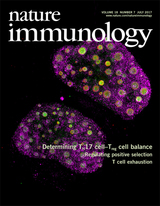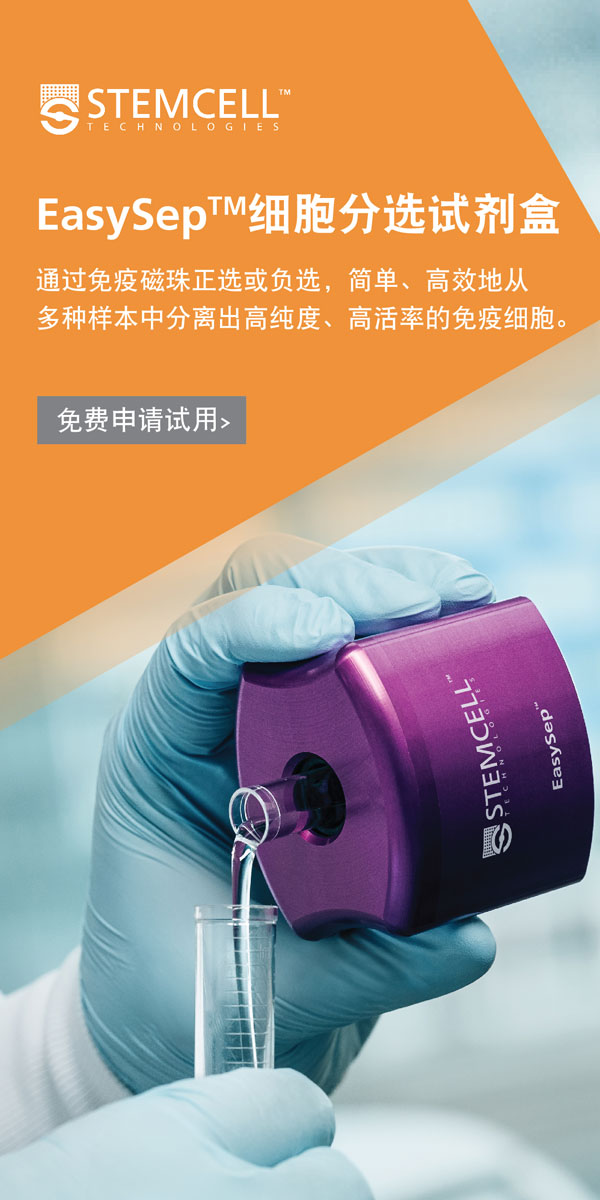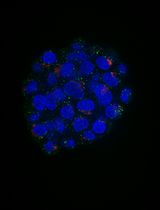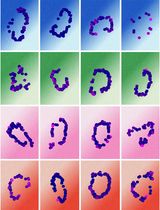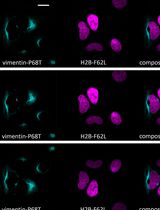- EN - English
- CN - 中文
Intravenous Labeling and Analysis of the Content of Thymic Perivascular Spaces
静脉标记和胸腺血管周围间隙含量分析
发布: 2018年03月05日第8卷第5期 DOI: 10.21769/BioProtoc.2757 浏览次数: 7598
评审: Ivan ZanoniYang FuMeenal Sinha
Abstract
Following development in the thymus, T cells are thought to exit into the periphery predominantly through perivascular spaces (PVS). This exit route is used by conventional T cells, and likely also applies to unconventional T cell subsets, such as precursors of CD8αα and TCRγδ intraepithelial lymphocytes, regulatory T cells and natural killer T cells. Additional cell types might also be found in the PVS and initiate interactions with exiting T cells. The exact content of the PVS, and the processes within, are not well studied. To distinguish vascular from resident cells within various tissues by flow cytometry, intravenous (i.v.) labeling is becoming a commonly employed method. We recently used anti-CD45.2 antibodies and magnetic enrichment to further evaluate this technique, and compared labeled and unlabeled cells in the thymus and blood. This assay can be used to specifically investigate hematopoietic cell subsets within the PVS of the thymus.
Keywords: Perivascular spaces (血管周围间隙)Background
Immature thymocytes undergo a series of maturation steps, including positive and negative selection, which eliminate the majority of developing T cells. The resulting mature T cell pool is thereby shaped towards a higher proportion of beneficial clones and a reduced proportion of dangerous self-reactive clones. The thymus also produces less abundant T cell subsets that generally act to maintain immune system, tissue, and metabolic homeostasis, including: TCRγδ cells, regulatory T (Treg) cells, natural killer T (NKT) cells, intraepithelial lymphocyte (IEL) precursors, and mucosal associated invariant T (MAIT) cells. Mature thymocytes poised to emigrate into the periphery upregulate expression of the receptor (S1PR1) that recognizes sphingosine-1 phosphate (S1P), a lipid molecule present at high concentrations in the blood. S1PR1+ T cells migrate along an S1P gradient and wind up in vascular circulation.
The thymic perivascular spaces (PVS) are basement membrane-separated compartments between the parenchyma and the vasculature. They are thought to facilitate trafficking of cells, especially mature T cells emigrating from the thymus (Mori et al., 2007; Weinreich and Hogquist, 2008; Zachariah and Cyster, 2010). The exact content of the PVS is not well characterized yet, and could include antigen presenting cells such as dendritic cells and macrophages, that carry antigens not normally expressed in the thymus, into this tissue to contribute to thymocyte selection processes.
Intravenous (i.v.) labeling is a technique commonly used to distinguish vasculature-associated circulating cells from those residing within tissues at the time of analysis (Anderson et al., 2014). Cyster and colleagues have used this approach to identify CD4+ emigrating T cells within the PVS, and showed that upon tail-vein injection of CD4-labeling antibody, CD4 T cells in the PVS are positively labeled within 3 min (Zachariah and Cyster, 2010). We sought to establish whether thymic precursors of CD8αα IEL, an agonist selected T cell subset that downregulates both CD4 and CD8 expression during thymic maturation, can also be found in the PVS. In order to do so, we adapted the i.v. labeling approach, using phycoerythrin (PE)-conjugated anti-CD45.2 (for C57BL/6 mice). As CD45 is not T cell specific, but is expressed by hematopoietic cells in general, various cells can be identified within the i.v.-labeled (IV+) fraction. Furthermore, we combined this with magnetic enrichment for the PE-conjugated antibodies. This allowed us to more closely evaluate the perivascular contents.
Materials and Reagents
- 1.5 ml microcentrifuge tubes (DOT Scientific, catalog number: 509-FTG )
- Aluminum foil (Spring Grove)
- 6-well plates (Corning, Costar®, catalog number: 3506 )
- 70 μm cell strainers (Corning, Falcon®, catalog number: 352350 )
- 1 ml insulin syringes (BD, catalog number: 329420 )
- 3 ml syringes (Covidien, catalog number: 8881513918 )
- 5 ml polystyrene round-bottom tubes (flow cytometry tubes; Corning, Falcon®, catalog number: 352008 )
- 15 ml conical centrifuge tubes (Corning, Falcon®, catalog number: 352097 )
- 96 round-bottom well plates (SARSTEDT, catalog number: 82.1582.001 )
- MACS LS columns (Miltenyi Biotec, catalog number: 130-042-401 )
- Mice, C57BL/6J, 5-6 weeks old (THE JACKSON LABORATORY, catalog number: 000664 )
- Anti-CD45.2 PE clone 104 (Tonbo Biosciences, catalog number: 50-0454-U100 ; 0.2 mg/ml)
- Heparin sodium injection (Sagent Pharmaceuticals, NDC 25021-400-10; 10,000 USP units per 10 ml)
- Phosphate buffered saline (PBS) (Corning, Mediatech, catalog number: 21-040-CV )
- Isoflurane (Piramal Healthcare, 001725CS)
- Anti-PE MicroBeads (Miltenyi Biotec, catalog number: 130-048-801 )
- Live/Dead Fixable Aqua kit (Thermo Fisher Scientific, InvitrogenTM, catalog number: L34957 )
- CD1d-tetramer (PBS57-loaded CD1d-monomers and tetramers available from NIH tetramer core facility; http://tetramer.yerkes.emory.edu)
- Anti-CD25 clone PC61 (e.g., BioLegend, catalog number: 102024 )
- Anti-TCRβ clone H57-597 (e.g., BD, BD Biosciences, catalog number: 562841 )
- Anti-CD4 clone RM4-5 (e.g., BioLegend, catalog number: 100548 )
- Anti-CD8α clone 53-6.7 (e.g., BD, BD Biosciences, catalog number: 563332 )
- Anti-CD5 clone 53-7.3 (e.g., Thermo Fisher Scientific, eBioscience, catalog number: 47-0051-82 )
- Anti-CD122 clone TM-b1 (e.g., Thermo Fisher Scientific, eBioscience, catalog number: 46-1222-82 )
- Anti-H-2Kb clone AF6-88.5 (e.g., BD, BD Biosciences, catalog number: 562942 )
- Anti-PD-1 clone J43 (e.g., Thermo Fisher Scientific, eBioscience, catalog number: 17-9985-82 )
- Anti-NK1.1 clone PK136 (e.g., BioLegend, catalog number: 108705 )
- Anti-CD11c clone N418 (e.g., Thermo Fisher Scientific, eBioscience, catalog number: 25-0114-82 )
- Anti-I-Ab clone AF6-120.1 (e.g., BioLegend, catalog number: 116421 )
- Anti-CD19 clone 1D3 (e.g., Thermo Fisher Scientific, eBioscience, catalog number: 56-0193-82 )
- Anti-CD11b clone M1/70 (e.g., Thermo Fisher Scientific, eBioscience, catalog number: 11-0112-41 )
- Anti-GR1 clone Gr-1 (e.g., BioLegend, catalog number: 108411 )
- Fetal bovine serum (FBS) (Atlanta Biologicals, catalog number: S11150 ), heat inactivated at 65 °C
- Ethylenediamine tetraacetate acid (EDTA) (Fisher Scientific, catalog number: BP120-500 )
- Sodium azide (Fisher Scientific, catalog number: BP922I-500 )
- Ammonium chloride (NH4Cl) (Sigma-Aldrich, catalog number: A4514-500G )
- Potassium bicarbonate (KHCO3) (Fisher Scientific, catalog number: P235-500 )
- Bovine serum albumin (BSA) (Sigma-Aldrich, catalog number: A7906 )
- FACS buffer (see Recipes)
- ACK lysis buffer (see Recipes)
- MACS buffer (see Recipes)
Equipment
- Class-II biosafety cabinet/laminar flow hood
- MACS Multistand (Miltenyi Biotec, catalog number: 130-042-303 )
- QuadroMACS Separator (Miltenyi Biotec, catalog number: 130-090-976 )
- Heat lamp
- Timer (Fisher Scientific, catalog number: 14-649-17 )
- Benchtop centrifuge (Beckman Coulter, model: Allegra X-12-R )
- 2,000 ml drop glass jar
- Refrigerator (4 °C) (Fisher Scientific, model: IsotempTM General-Purpose Series Lab Refrigerator )
- Hemacytometer (Sigma-Aldrich, catalog number: Z359629-1EA )
- FACS flow cytometer (BD, model: LSR-II , H10.10)
Software
- FlowJo version 10.4.0
Procedure
文章信息
版权信息
© 2018 The Authors; exclusive licensee Bio-protocol LLC.
如何引用
Ruscher, R. and Hogquist, K. A. (2018). Intravenous Labeling and Analysis of the Content of Thymic Perivascular Spaces. Bio-protocol 8(5): e2757. DOI: 10.21769/BioProtoc.2757.
分类
免疫学 > 动物模型 > 小鼠
细胞生物学 > 细胞成像 > 荧光
您对这篇实验方法有问题吗?
在此处发布您的问题,我们将邀请本文作者来回答。同时,我们会将您的问题发布到Bio-protocol Exchange,以便寻求社区成员的帮助。
Share
Bluesky
X
Copy link


